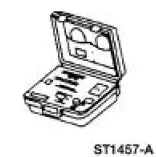Ford Mustang (1999-2004) Service Manual: Refrigerant Identification Testing
Special Tool(s)
 |
Refrigerant Identifier with Air- Radicator 198-00003 or equivalent |
1. NOTE: An A/C refrigerant analyzer must be used to identify gas samples taken directly from the refrigeration system or storage containers prior to recovering or charging the refrigerant system.
Follow the instructions included with the Deluxe Refrigerant Diagnostic Tool to obtain the sample for testing.
2. The diagnostic tool will display one of the following:
- If the purity level of R-134a or R-12 is 98% or greater by weight, the green "PASS" light emitting diode (LED) will light. The weight concentrations of R-134a, R-12, R-22, hydrocarbons, and air will be displayed on the digital display.
- If refrigerants R-134a or R-12 do not meet the 98% purity levels, the red "FAIL" LED will light and a horn will sound alerting the user of potential hazards. The weight concentrations of R-134a, R-12, R-22, and hydrocarbons will be displayed on the digital display.
- If hydrocarbon concentrations are 2% or greater by weight, the red "FAIL" LED will light, "Hydrocarbon High" will be displayed on the digital display, and a horn will sound alerting the user of potential hazards. The weight concentrations of R-134a, R-12, R-22, and hydrocarbons will also be displayed on the digital display.
3. The percentage of air contained in the sample will be displayed if the R-134a or R-12 content is 98% or greater. The diagnostic tool eliminates the effect of air when determining the refrigerant sample content because air is not considered a contaminant, although air can affect A/C system performance. When the diagnostic tool has determined that a refrigerant source is pure (R-134a or R-12 is 98% or greater by weight) and air concentration levels are 2% or greater by weight, the diagnostic tool will prompt the user if an air purge is desired.
4. If contaminated refrigerant is detected, repeat the refrigerant identification test to verify that the refrigerant is indeed contaminated.
5. CAUTION: If contaminated refrigerant is detected, DO NOT recover the refrigerant into R-134a or R-12 recovery/recycling equipment.
Recover any contaminated refrigerant using suitable recovery-only equipment designed for capturing and storing contaminated refrigerant. For additional information, refer to Contaminated Refrigerant Handling in this section.
 Inspection and Assembly Requirements - Following an
A/C
Compressor Failure
Inspection and Assembly Requirements - Following an
A/C
Compressor Failure
CAUTION: To prevent refrigerant system contamination and possible
failure of the new
A/C compressor, carry out the following procedures.
1. NOTE: A dirty A/C evaporator core orifice or a condenser to ...
 Contaminated Refrigerant Handling
Contaminated Refrigerant Handling
1. CAUTION: If contaminated refrigerant is detected, DO NOT recover the
refrigerant
into your recovery/recycling equipment.
Recover the contaminated refrigerant using suitable recovery-only equipment ...
Other materials:
Starter Drive and Flywheel Ring Gear Inspection
1. Remove the starter motor. For additional information, refer to Starter
Motor-3.8L or Starter
Motor-4.6L in this section.
2. Check the wear patterns on the starter drive gear and the flywheel ring
gear . If the wear pattern
is normal, install the sta ...
Wipers and Washers
General Specifications
Torque Specifications
Wipers and Washers
The wiper and washer system consists of the following components:
windshield wiper mounting arm and pivot shaft
pivot arms
windshield wiper blades
windshield washer reservoir
...
Engine (Removal)
Special Tool(s)
Lifting Bracket Set, Engine
303-D095 (D94L-6001-A) or
equivalent
Spreader Bar
303-D089 (D93P-6001-A3) or
equivalent
Heavy Duty Floor Crane
014-00071 or equivalent
Removal
WARNING: Do not smoke or ...
